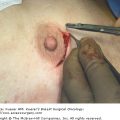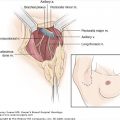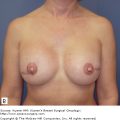Women with breast cancer and those who are at increased risk of developing breast cancer may consider mastectomy as an option for treatment or a step toward risk reduction. Historically, mastectomy in the absence of breast reconstruction was associated with a significant change in body image. For this reason, breast-conservation therapy emerged as an oncologically safe and emotionally less impacting option for the surgical treatment of breast cancer. Following the reporting of pivotal trials from Milan and the National Surgical Adjuvant Breast and Bowel Project (NSABP) in the 1970s and 1980s, breast-conservation rates rose dramatically. In recent years, however, mastectomy rates are increasing. This is thought to be at least in part due to improvements in cosmetic outcomes after mastectomy.
Initially the Halsted radical mastectomy, which resected en bloc the breast, regional lymph nodes, and underlying pectoralis muscles, left a severely disfigured chest wall and resulted in significant morbidity. Adoption of the modified radical mastectomy (MRM) technique allowed preservation of the pectoralis major and minor muscles, and internal mammary and supraclavicular nodal basins, resulting in significantly less disfigurement and reducing morbidity. The goal of mastectomy is to remove all breast tissue; data suggest that approximately 95% of breast tissue is resected in a traditional simple or modified radical mastectomy. The anatomical boundaries of the breast are the clavicle superiorly, the inframammary fold inferiorly, the sternum medially, and the mid-axillary line laterally. Sufficient skin overlying the chest wall is preserved at the time of a simple mastectomy in order to allow coverage of the chest wall and primary closure of the incision.
Since the skin is not part of the glandular breast tissue itself but rather an envelope around the breast tissue, the idea of preserving the skin envelope led to the development of skin-sparing mastectomy (SSM). Skin-sparing mastectomy was first described by Toth and Lappert in the literature in 1991.1 I describes the procedure of mastectomy, either simple or modified radical, with a minimum amount of skin excision. The surgical skin excision must (1) include the nipple-areolar complex (NAC), (2) include the biopsy site, and (3) allow for access to the axilla for possible dissection. Also incorporated into the SSM definition are preservation of both the inframammary fold and any uninvolved skin. Early SSM excised an ellipse of skin encompassing the NAC and some of the surrounding skin medially and laterally, but preserved more of the skin overlying the breast than conventional mastectomy. This incision afforded wide access to the boundaries of the breast, and resulted in removal of a similar amount of breast tissue and a similar long horizontal incision, but preserved more of the skin envelope for immediate reconstruction. As the technique evolved, smaller and smaller incisions provided appropriate access to the breast tissue and maximal skin preservation. Currently, most surgeons utilize a circumareolar incision that resects the NAC while preserving the entirety of the breast envelope.
With the advent of SSM, investigators appropriately questioned whether preservation of the skin envelope results in higher risk of local-regional recurrence. If SSM is not performed meticulously, and additional breast tissue is left on the skin flaps, the risk for local recurrence could be higher due to technically inadequate surgery. Multiple studies have evaluated the question of recurrence and established the oncological safety of the SSM approach. In patients matched for stage and length of followup (41-72 months), studies have shown favorable or equivalent rates of local recurrence with 3.9% to 9.5% recurrence in simple mastectomies compared to 0% to 7.0% in SSM (Table 66-1). Similarly, Slavin et al2 reported an 11.7% (14/120) locoregional recurrence rate after non-SSM with immediate flap reconstruction with a median follow-up of 5.4 years. No patients with stage 0 or I breast cancer in this study recurred. No studies have demonstrated that the timing of reconstruction compromises the primary surgical resection, alters survival, or interferes with the detection and treatment of tumor recurrence. Based on the data from these studies, immediate reconstruction has gained acceptance and popularity.
| Study | Institution | F/U | N (SSM) | LR in SSM (%) | N (NSSM) | LR in NSSM (%) | p-Value |
|---|---|---|---|---|---|---|---|
| Carlson (1997)17 | Emory | 41 | 327 | 4.8 | 188 | 9.5 | NS |
| Kroll (1999)25 | MDACC | 72 | 114 | 7.0 | 40 | 7.5 | NS |
| Rivadeneira (2000)26 | Cornell | 49 | 71 | 5.6 | 127 | 3.9 | NS |
| Gerber (2003)6 | Munich | 59 | 112 | 5.4 | 134 | 8.2 | NS |
| Newman (1998)4 | MDACC | 50 | 437 | 6.2 | |||
| Carlson (2003)27 | Emory | 65 | 565 | 5.5 | |||
| Toth (1999)28 | California Pacific | 57 | 50 | 0 |
The main advantage of SSM is the preservation of the skin envelope, which maintains the natural breast contour for the reconstruction to fill. Additionally, the shorter incision results in decreased scarring and improved cosmesis. The cosmetic outcome from a SSM with immediate reconstruction is better in women with a smaller body habitus than obese women. This is mainly due to the ability of the reconstruction to fill the natural skin envelope. Nipple-sparing mastectomy is the latest advancement in technique to preserve more tissue and improve cosmesis (see Chapter 67). Patient selection for SSM is important. Patients with inflammatory breast cancer are not candidates for SSM. Similarly, in cases of locally advanced breast cancers with skin involvement, a skin-sparing approach is not recommended. Neoadjuvant chemotherapy can convert a locally advanced breast cancer with skin involvement into a candidate for SSM if the skin changes completely resolve. However, if residual skin changes remain, SSM is not advised. Intraoperative analysis of margins is important for a skin-sparing approach and if the tumor extends close to the anterior margin, the overlying skin is often resected. Close margin does not, however, necessarily require conversion to a total mastectomy. Often, the skin in the area overlying the tumor can be resected either as an extension of the NAC incision or via a separate incision directly over the tumor.
Smoking is a relative contraindication to SSM. Most breast surgeons and plastic surgeons will not perform a SSM with immediate reconstruction on a patient who is actively smoking. This is due to the effect of smoke on small vessels and the associated increased risk of necrosis of the skin flaps and vasoconstriction of the myocutaneous flaps. The skin envelope of the native breast loses the blood supply from the underlying breast after SSM, and therefore the viability of the skin is dependent on the medial perforators. The larger the breast and the longer the skin flap, the higher the risk of skin necrosis. Surgeons vary in the minimum acceptable period of smoking cessation prior to surgery. Some surgeons will operate as few as 2 weeks smoke-free whereas others require 6 weeks. Nicotine levels in the urine can be checked to confirm smoking cessation.
Patients not interested in any form of immediate reconstruction should undergo simple mastectomy with the goal of resecting enough skin to create a flat chest wall. This optimizes healing and allows the best fit for an external prosthesis. The advantage of the skin-sparing technique is for the immediate reconstruction and, therefore, if reconstruction is not planned excess skin should be removed rather than preserved for potential delayed reconstruction. Skin-sparing mastectomy may be utilized in conjunction with autogenous tissue or implant-based reconstructions. These techniques provide superior cosmesis compared to a conventional mastectomy and compared to delayed reconstruction.
Patients who are likely to require postmastectomy radiation should consider the complications associated with radiation of a reconstructed breast before proceeding with SSM with reconstruction. Women with larger tumors (>5 cm), close margins, and positive lymph nodes may be considered for postmastectomy radiation and this can affect the outcome from SSM.
As most recurrences will occur in skin of the chest wall, the ability to detect local recurrence is not impaired following SSM. Due to an absence of breast tissue, routine screening mammogram is not indicated for annual surveillance. Any recurrence is usually superficial and detected by physical examination. When any new palpable abnormality is detected, complete workup with mammogram, ultrasound, and magnetic resonance imaging (MRI) as indicated with biopsy of the lesion is recommended to rule out local recurrence.
The final appearance of the reconstructed breast is greatly dependent on the relative amounts of skin and breast tissue excised at the time of the mastectomy and on the exact location of the skin incision. A complete mastectomy may be performed using modified skin incisions to avoid the sacrifice of unnecessary breast skin. The type of skin-sparing incision used varies based on the exact location of the tumor and the size of the breast, but it always includes the NAC and the biopsy site.
Input from the plastic surgeon regarding orientation and extent of skin incisions for SSM with immediate reconstruction is important, especially when a nonstandard incision is required in order to resect any additional skin due to concern of involvement with tumor.1
Careful intraoperative evaluation of the mastectomy specimen is an important component to minimize the risk of positive margins following SSM. Intraoperative inking of margins with frozen section analysis of any close margins to fully evaluate all areas of concern is recommended. Resection of additional skin should be performed as necessary. At MD Anderson Cancer Center (MDACC), mammography of serial sections of the mastectomy specimen is performed if calcifications are present to assess for calcifications approaching a margin. At the Mayo Clinic, intraoperative frozen section of the mastectomy specimen with margin evaluation is routinely performed. Close margins mandate additional margin resection inclusive of overlying skin if necessary. Often if there is clinical concern preoperatively about an area of skin, preoperative imaging with MRI or ultrasound can help evaluate whether skin resection is required. Additionally, any areas of concern clinically can be marked with a marking pen prior to incision and if pathology reveals close margins in this area, the skin is clearly marked allowing accurate resection of the correct area of overlying skin. At Dartmouth-Hitchcock Medical Center an alternative approach has been pioneered for transverse rectus abdominis muscle reconstruction (TRAM) reconstruction. In these women, a staged approach allows for the final inset of the TRAM 4 to 5 days following mastectomy. This allows final pathologic review prior to decisive closure. Nonviable mastectomy skin is replaced with redundant TRAM skin and reexcision of close or positive margins is based on final pathology. Although margins should be cleared surgically, postmastectomy radiation should be considered if postoperative margins are microscopically positive and not resected.
Stay updated, free articles. Join our Telegram channel

Full access? Get Clinical Tree







